


Roger Parsons was the main man behind the Minden Wildwater
Preserve. It was his vision, and his hardwork that made the
whole project come into being.
Whitewater Ontario, then known as the Ontario Wildwater Affilation, used the Gull for races long before that.
It always was the top spot to compete for slalom. Roger saw the potential.
At this time, how he went about this, is a mystery that needs to be uncovered. He is still alive and well, living outside Barrie (by Horseshoe Valley). Go ahead, give him a call and show your appreciation!
Over the years individuals like the Kerkhoff family supported the MWWP financially through donations. Actual hands on work was more done by Mike Twitchin, Heinz Poenn and family, the Blight family, plus many more names we need to look up.
Dieter Poenn and Claudia Kerkhoff - both Canadian champs at the time, officially opened up the revised upper section of the Gull, by running the dam.
Roger Parsons - the heart and soul, inspiration and man of motion behind the MWWP - the foundation of whitewater paddling in Canada period is still going strong - - strong, active and still paddling (sea kayaks these days)....in his 80's he still has his MWWP scrapbook, site plan etc. at his place in Midhurst.
He likely will be a presenter at this years Gull River Festival, and we hope will - lead the evenings " Square Dance " - bringing back an old tradition, Roger is a caller (still active calling square dances in the Barrie area 3-4 times per week).
Roger passed on many archivial pieces of Ontario Paddling history to Dave Gillespie about 10 years ago, but still has a valuable scrap book which we plan to copy, mount and make a history exhibit for inside the building - ready for this years Gull Festival.
Roger had hoped that 25 years MWWP would be celebrated - that would have been 2004 but no-one around and active - knew about it.
Here is more on the preserve's history:
1969 - Canadian team members; Roger and Kathy (daughter) Parsons, Heinz Poenn, Keith Daniels, Hermann Kerckhoff ...and others were in desperate need of a whitewater training site, to prepare for the 1969 World Championships in Merano, Italy. They drove around Southern Ontario for 2 days (that year was a drought), when Roger suggested driving up to the Gull River. They arrived, it had water ! But, it was shallow in places, so felt some river work would make this an ideal slalom training site. Noticing a sign 'Land - for - Sale' on river left below the dam had them excited. 10 Cottage Lots were being sold all the way down the rapids shoreline by an American land-owner. Roger looked him up through the help of a local real-estate lady (whom he still bumps into in Minden), and asked if they could buy the top 3 lots to secure river access. Well the American then said - want you to take one or all 10. This meant raising $50,000.
Roger started writing letters to every paddler and organization to raise money. After 10 years of lobbying, getting pledge cards, collecting and in the end Roger raised $106,000 (mainly private $, and a small donation from the Cdn Nature Conservatory)
The municipality was not behind anything to do with paddlers. The reeve at that time was less than helpful but this all changed in 1979, when a new reeve was elected who was very keen, and spearheaded a lot of the support.
1979 - bought the land (10 Lots and a second piece behind for camping)
1980 - Opening of Site - big event with Reeve, other dignitaries and the whole paddling community. I remember this very well, as Dieter Poenn (Cdn mens champion) and Claudia Van wyk (Cdn womens champ) just returned from the World Championships, where they both placed 5th - best ever international placement by a Canadian, were asked to open up the 'river' by running the DAM. Well - it would be a first decent....and we were pretty scared, but keen at the same time. Man-made structures are unpredictable. Dieter ran it first (ha !) got a bit stuck in the hole, but Claudia managed to have a clean jump into river right eddy !
1983 - Building went up
_____________________
The Gull has hosted two World Cup events, numerous Canadian Championships and many other events including Freestyle.
Running the dam at Minden was part of the course at a World Cup Slalom race hosted there by the Ontario Wild Water Affiliation decades ago. This was a significant international race and I am sure that the international racers (or the local ones for that matter) weren't directed to do something 'illegal' as part of this internationally sanctioned race.
It is technically illegal to run the dam at the Gull, or be within 50m upstream or downstream of it. Apparently - according to discussions I have had in the past with the OPP - this applies to all the dams on the Trent/Severn system. The law has been used to charge at least one paddler: Joe Langman was charged at Fenelon Falls. I don't know what happened in that case.
The OPP has used the law to chase boaters away from 2 paddling sites: Lock 19 in Peterborough and the dam between 12 mile lake and Mountain Lake (just north of the Gull, right next to hwy 35).
Hydro has nothing to do with the dam at the Gull. It is owned and maintained by the National Parks System as part of the Trent/Severn waterway.
Possibly a "special permit" was issued for world-cup races.
recognition for the hard work and dedication they showed to paddling, paddlers and the Gull, in addition to the folks already mentioned.
The McCall family particularly Jeff and Jim gave mightily of their time, knowledge, and enthusiasm.
They acted as volunteer coaches and mentors, organized training sessions at the Gull that they coached and used as work parties.
The Brownsea base boys from Peterborough were also key to the early Ontario and Gull river paddling and slalom scene.
My first trips to the Gull were in 1974. The lakefield paddlers would surf the standing waves on the river upstream of Peterborough and go to races on weekends to legitimize ourselves as an official school sport.
The Gull was the holy grail and this was before the falls were blasted and the river channelized. Racing from the falls down was high adventure back then.
In 1975 I saw Dieter Poenn run the falls and then surf what now would be called whitehorse, which seemed much more fun than running gates. His mom was always there judging gates and shaking her head when we would knock gates out of our way and Heinz try to give us coaching and instruction if we would take it.
Another family who gave greatly to paddling and the Gull.
My memories of Hermann appear to be different.
It was Roger Parsons though, who took hold of the vision and cracked the whip.
We wouldn't have the Gull in anywhere near its form if not for him.
Thanks Roger
River protection and access protections unfortunately also bring regulation with them. Regulation by beurocrats with little or no understanding or appreciation for us or what we do. See the situation on the upper chattoooga where boat ing is outlawed but fishing, hiking, camping are good to go.
The Problem with minden
The essential problem with Minden
It is a high value asset. The property is probably close a million dollars in value. WO owns 17 acres. In addition, shoreline land is leased from Orillia Light and Power for a nominal fee to allow for river access.
The dam is a water controlled structure owned and operated by Parks Canada as part of the Trent severn waterway.
It is obviously of great interest to paddlers. Above Horseshoe falls is technical class III-IV. Below class two-three. All dependent on water levels.
At the dam hydraulic holes develop at the sluice which can hold a boat but with new technology in boats often are side surfed by skilled paddlers.
The first drop below the dam contains an "augsberg" eddy. It has been said that a paddler who can navigate the upper section: dam to below horseshow falls, hitting every eddy, can probably navigate almost anything else. You be the judge.
The limestone rock at Minden is encrusted with mica and is razor sharp: swimmer unfriendly.
At one time it was felt that Voyageur island, midstream below the dam was in danger of eroding and causing deterioration of the navigability of the river.
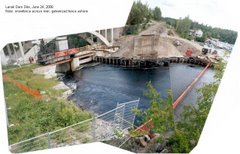


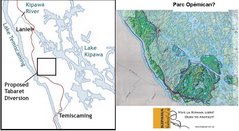

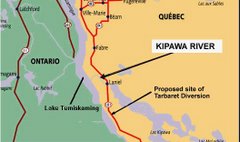

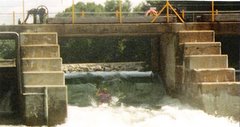



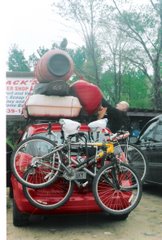
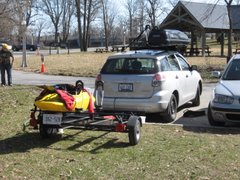

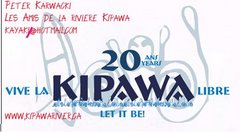
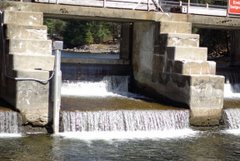


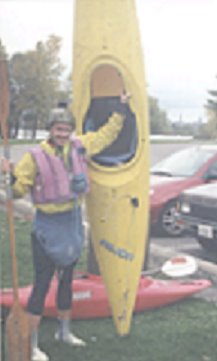



No comments:
Post a Comment